顔の錯視
2007年6月21日より
「サッチャー錯視のイラスト版」
左の図は笑顔の女性を描いたイラストをさかさまにしたもので、右の図は左の図の目と口をそれぞれ上下反転させたものである。右の図を見るとあまり奇妙な感じは受けないが、図をさかさまにして見る(下図)と、かなり奇妙な顔になっていることがわかる。この錯視はサッチャー錯視と呼ばれ、Peter Thompson先生が1980年(サッチャーが首相になった次の年)に発表した。Peterは自分自身の顔でもやっているが、ヒゲまでさかさまにするのは反則では(笑)。
Copyright Akiyoshi Kitaoka 2007 (November 15)
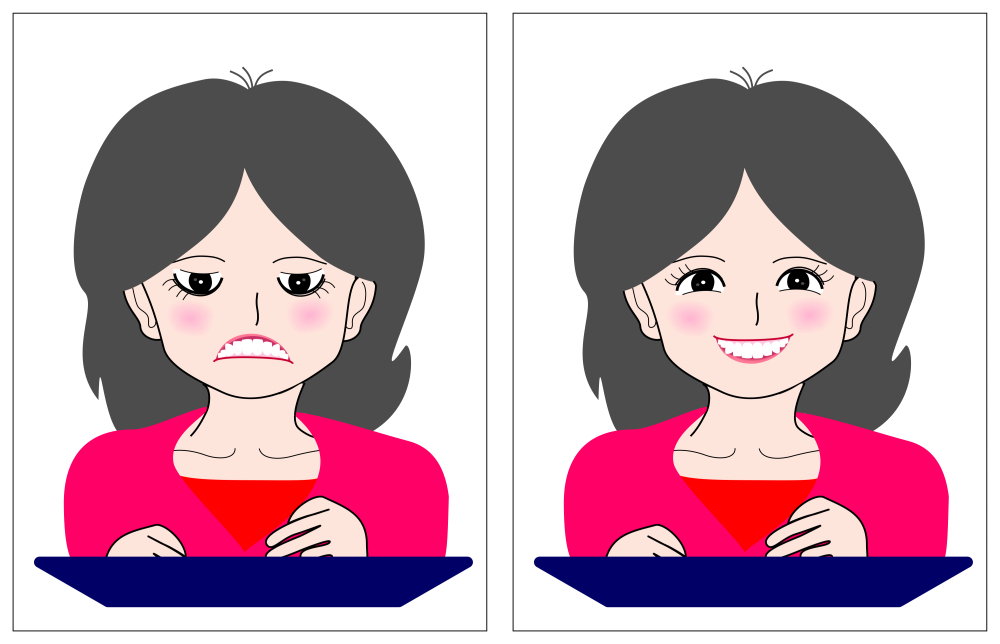
文献(2007年11月、北岡の調査による)
Arnheim, R. (1954) Art and visual perception: A psychology of the eye. Berkeley: University of California Press.
Bartlett, J. C. and Searcy, J. (1993) Inversion and configuration of faces. Cognitive Psychology, 25, 281-316.
Bertin, E. and Bhatt, R. S. (2004) The Thatcher illusion and face processing in infancy. Developmental Science, 7, 431–436.
Boutsen, L. and Humphreys, G. W. (2002) Face context interferes with local part processing in a prosopagnosic patient. Neuropsychologia, 40, 2305-2313.
Boutsen, L. and Humphreys, G. W. (2003) The effect of inversion on the encoding of normal and "thatcherized" faces. Quarterly Journal of Experimental Psychology A, 56, 955-975.
Boutsen, L., Humphreys, G. W., Praamstra, P., and Warbrick T. (2006) Comparing neural correlates of configural processing in faces and objects: an ERP study of the Thatcher illusion. Neuroimage, 32, 352-367.
Carbon, C. C., Schweinberger, S. R., Kaufmann, J. M., and Leder H. (2005) The Thatcher illusion seen by the brain: an event-related brain potentials study. Cognitive Brain Research, 24, 544-555.
Carey, S. and Diamond, R. (1977) From piecemeal to configurational representation of faces. Science, 195 (4275,) 312-314.
Diamond, R. and Carey, S. (1986) Why faces are and are not special: An effect of expertise. Journal of Experimental Psychology: General, 115, 107-117.
Edmonds, A. J. and Lewis, M. B. (2007) The effect of rotation on configural encoding in a face-matching task. Perception, 36, 446-460.
Ellis, H. D. (1975) Recognising faces. British Journal of Psychology, 66, 409-426.
Farah, M. J., Tanaka, J. W., and Drain, H. M. (1995) What causes the face inversion effect? Journal of Experimental Psychology: Human Perception and Performance, 21, 628-634.
Goldstein, A. G. (1965) Learning of inverted and normally oriented faces in children and adults. Psychonomic Science, 3, 447-448.
Leder, H., Candrian, G., Huber, O., and Bruce, V. (2001) Configural features in the context of upright and inverted faces. Perception, 30, 73-83.
Lewis, M. B. (2001) The Lady's not for turning: Rotation of the Thatcher
illusion. Perception, 30, 769-774.
Lewis, M. B. (2003) Thatcher's children: Development and the Thatcher illusion.
Perception, 32, 1415-1421.
Lewis, M. B. and Johnston, R. A. (1997) The Thatcher illusion as a test of configural disruption. Perception, 26, 225-227.
Lobmaier, J. S. and Mast, F. W. (2007) The Thatcher illusion: Rotating the viewer instead of the picture. Perception, 36, 537-546.
Milivojevic, B., Clapp, W. C., Johnson, B. W., and Corballis, M. C. (2003) Turn that frown upside down: ERP effects of thatcherization of misorientated faces. Psychophysiology, 40, 967-978.
Murray, J. E., Yong, E., and Rhodes, G. (2000) Revisiting the perception of upside-down faces. Psychological Science, 11, 492–496.
Parks, T. E. (1983) Letters to the Editor. Perception, 12, 88.
Parks, T. E., Coss, R. G., and Coss, C. S. (1985) Thatcher and the Cheshire cat: context and the processing of facial features. Perception, 14, 747-754.
Rakover, S. S. (1999) Thompson's Margaret Thatcher illusion: when inversion
fails. Perception, 28, 1227-1230.
Rakover, S. S. and Teucher, B. (1997) Facial inversion effects: parts and whole relationship. Perception & Psychophysics, 59, 752-761.
Rhodes, G., Brake, S., and Atkinson, A. P. (1993) What's lost in inverted faces? Cognition, 47, 25-57.
Rock, I. (1974) The perception of disoriented figures. Scientific American, 230, 78-85.
Rock, I. (1988) On Thompson's inverted-face phenomenon (Research Note).
Perception, 17, 815-817.
Rouse, H., Donnelly, N., Hadwin, J. A., and Brown, T. (2004) Do children with autism perceive second-order relational features? The case of the Thatcher illusion. Journal of Child Psychology and Psychiatry, 45, 1246–1257.
Sjoberg, W. and Windes, J. (1992) Recognition times for rotated normal and "Thatcher" faces. Perceptual and Motor Skills, 75, 1176-1178.
Stürzel, F. and Spillmann, L. (2000) Thatcher illusion: Dependence on angle of rotation. Perception, 29, 937-942.
Tanaka, J. W. and Farah, M. J. (1993) Parts and wholes in face recognition. Quarterly Journal of Experimental Psychology A., 46, 225-245.
Thompson, P. (1980) Margaret Thatcher: a new illusion. Perception, 9, 483-484.
Valentine, T. (1988) Upside-down faces: A review of the effect of inversion upon face recognition. British Journal of Psychology, 79, 471-491.
Valentine, T. and Bruce, V. (1988) What's up? The Margaret Thatcher illusion
revisited. Perception, 14, 515-516.
Yin, R. K. (1969) Looking at upside-down faces. Journal of Experimental Psychology, 81, 141-145.
「よそ見をする人」
4つとも同じ図で向きが違うだけであるが、左下の人だけは本を見ているように見えることがあるが、他の3つでは本を見ているようには見えない。
Copyright Akiyoshi Kitaoka 2007 (June 20)
「さかさま顔の過大視」
上下の顔の大きさは同じであるが、下の方が大きく見える。
Copyright Akiyoshi .Kitaoka 2007 (February 16)
cf. 上視野の過大視、サッチャー錯視
さかさま顔の過大視の研究のページ
(2007年6月9日)
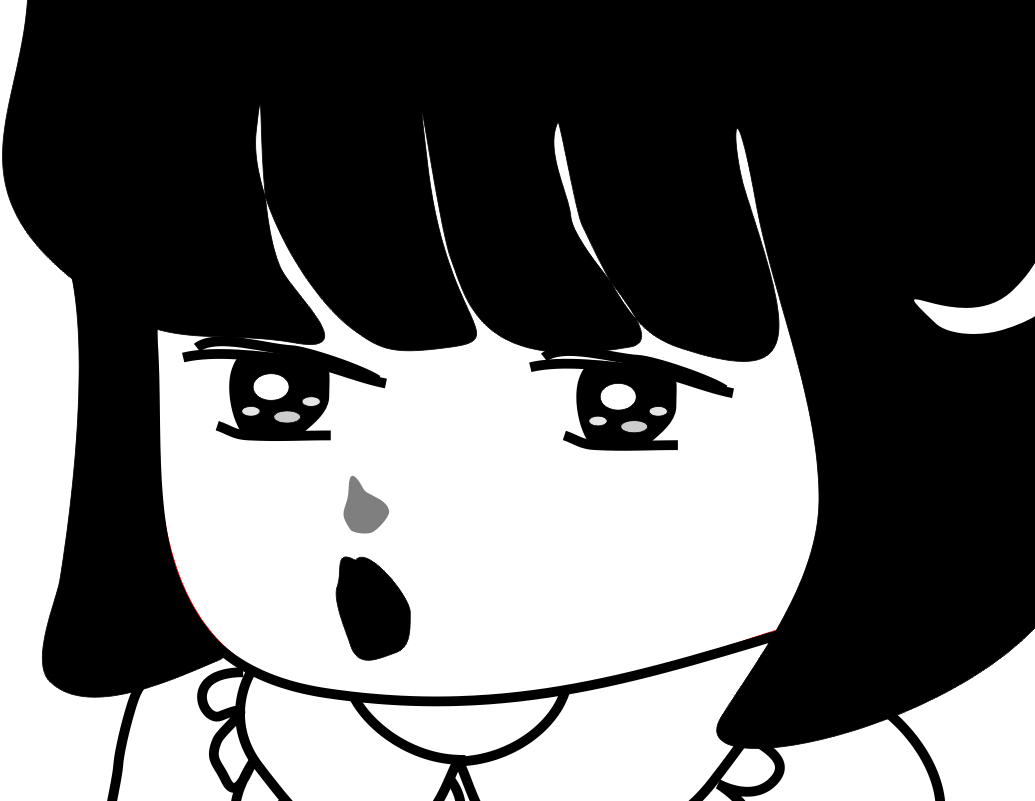
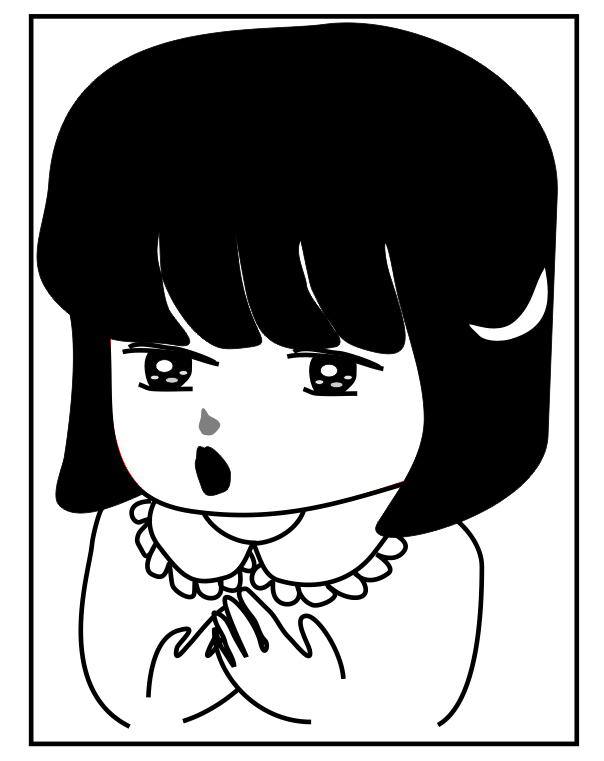
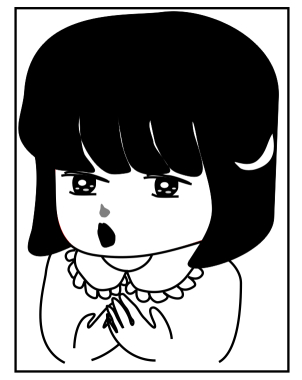
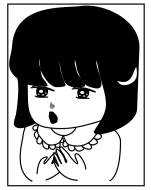

「図の大きさによる視線方向錯視」
これらの図は絵としては同じ図で大きさが異なるだけであるが、図が大きい時(上の方の図)、視線はやや下向きのように見えるのに対し、図が小さい時(下の方の図)、視線は前方に向いているように見える。パソコン画面を近くから見るのと遠くから見るのとを比較した場合でも、同じ効果が得られる。
Copyright Akiyoshi Kitaoka 2007 (May 3)
めがねをかけている人は、大きい図をめがねなしで見ると、視線が前方に向いて見える場合がある。Oliva の Hybrid Images (日本では「マリリンシュタイン」の画像で有名)も参照されたい。
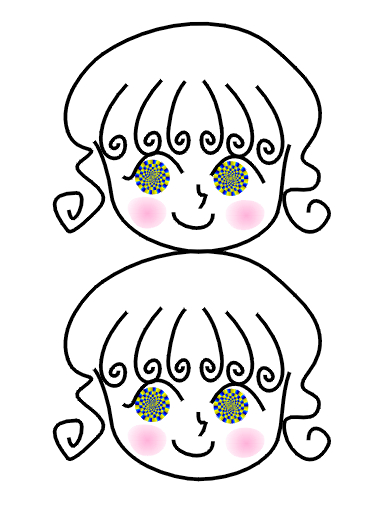
「顔ジャストロー錯視」
同じ大きさの顔であるが、下の方が大きく見える。
Copyright Akiyoshi Kitaoka 2006 (August 4)
学生が普通の人の顔写真でも起きることを確かめた(2006年度後期)。

「頭の高さの錯視」
右の図ほど頭の高さが高いように見えるが、実際には同じ高さである。
Copyright Akiyoshi Kitaoka 2006 (August 2)
「視線方向の錯視3」
画像1では、女の子はやや下の方を見ているように見える。マウスを画像に乗せると画像2となり、画像2では女の子はやや上の方を見ているように見える。しかし、絵としては、顔の輪郭と髪の輪郭以外はすべて同じである。
Copyright Akiyoshi .Kitaoka 2006 (August 1)
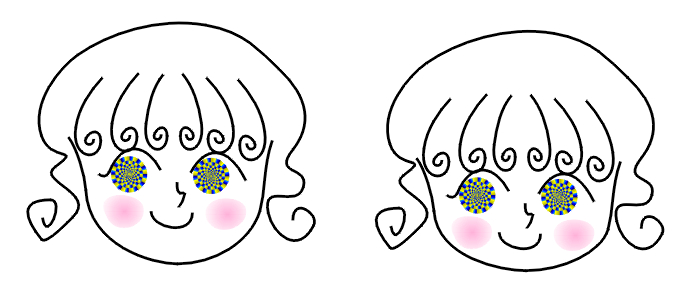
「視線方向の錯視2」
画像1では、女の子は上を見ているように見える。マウスを画像に乗せると画像2となり、画像2では女の子はこちらを見ているように見える。しかし、絵としては、顔の輪郭と髪の輪郭以外はすべて同じである。この錯視を視線方向の錯視というかどうかは定かでない。
Copyright Akiyoshi Kitaoka 2006 (July 21)
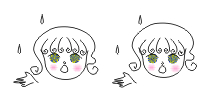
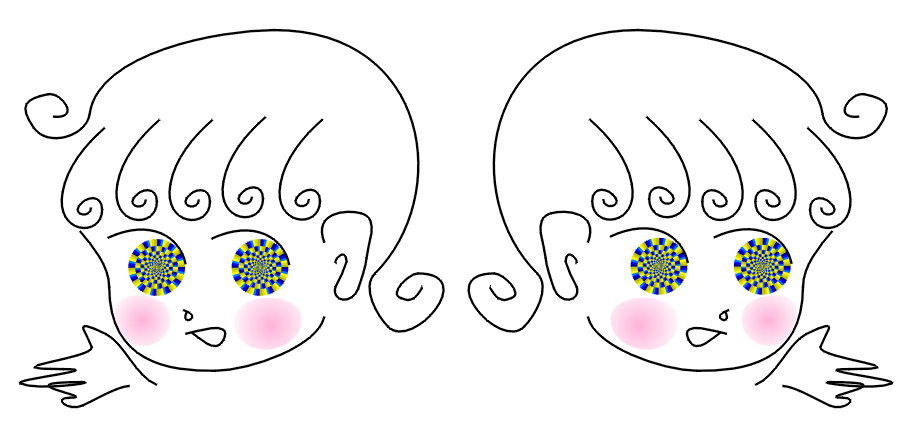
「視線方向の錯視」
向かって左の女の子はこちらを見ているように見えるが、向かって右の女の子は向かって右の方向を見ているように見える。しかし、絵としては、両者とも同じ目である。この錯視を視線方向の錯視(Wollaston, 1824)という。なお、原画は若いお兄さん。
Copyright Akiyoshi Kitaoka 2006 (July 20)
今月の心理学ワールド(日本心理学会の会員に配られる日本語雑誌)で山口先生(中央大学の研究室)の解説を読むまでこれが錯視とは知らなかった、という事実は恥ずかしいので墓場に入るまで秘密にしておこう。よく見かけるお兄さんの絵だなー、と思っていたが、説明が英語の場合が多く、読むのが面倒なのでほっといたらこのざまである。顔の研究では「視線方向の錯視」と呼んでいるのだろうか。錯視研究における慣例的命名法から考えると、ウォラストン錯視と呼びたい感じである。山口先生は「ワラストン」と表記しているけど「ウォラストン」でなくて大丈夫? などということは恥ずかしくて聞けない。なお、Wollastonはこの人らしい。ずいぶんいろいろな研究業績があるようだ。日本語の解説ページはこちら。彼が発明した偏光プリズムが「ウォラストンプリズム」という名称で日本では知られているようなので、ウォラストンの方がよいかな。
Wollaston, W. H. (1824) On the apparent direction of eye in a portrait. Philosophical Transactions of the Royal Society of London, B114, 247-256. (下記山口先生の解説から孫引き)
山口真美 (2006) 乳児に視線はどう見えるのか? 心理学ワールド, 34(特集・視線とコミュニケーション), 5-8.